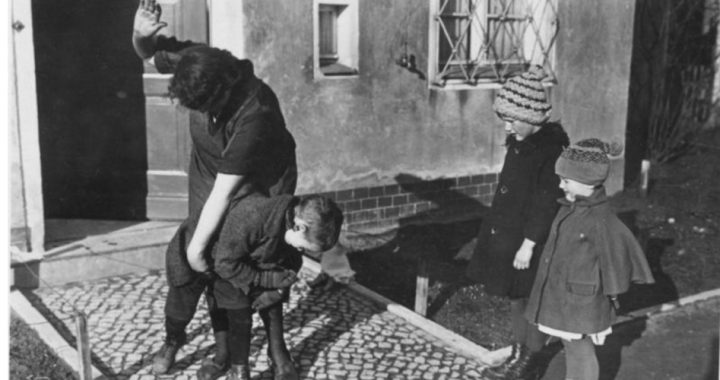
We’re a long way from TV depictions of corporal punishment, such as the spanking of the main character in the 1957 film The Invisible Boy (yes, he was invisible at the time). Now we live in an age when many want to make spanking disappear. And recent comments Pope Francis has made — in support of the practice — have once again brought the issue to the forefront.
During his general audience Wednesday in St. Peter’s Square, the Pope indicated that corporal punishment was a legitimate tool as long as a child isn’t robbed of his dignity. Reports CNN:
“I once heard at a wedding a father say, ‘I sometimes have to hit my children a little but never in the face, so as to not demean them.’ How nice, I thought, he has a sense of dignity,” the Pope said.
“When he punishes, he does it right and moves on.”
… “A good father knows how to wait and knows how to forgive from the bottom of his heart. Of course he can also discipline with a firm hand: he’s not weak, submissive, sentimental,” he said.
“This father knows how to discipline without demeaning; he knows how to protect without restraint.”
The issue of corporal punishment for children is divisive in many countries, and the Pope’s remarks prompted an outpouring of both support and criticism on social media.
One country attacking the Pope’s comments is Germany, where spanking — also known as “smacking” in much of the Anglosphere — is illegal. Writes ABC News:
Germany and a leading anti-corporal punishment group on Friday rejected as “unacceptable” the pope’s comments that it’s OK to spank your children to discipline them, as long as their dignity is maintained.
… Verena Herb, a spokeswoman for Germany’s Families Ministry, told reporters on Friday that “there can be no dignified hitting.”
Spanking is legal in most of the world, and unpleasant physical punishment has been a staple of parenting since time immemorial. For example, some American Indians would immerse misbehaving children in cold water. Nonetheless, Western “elites” are bent on eliminating spanking and have succeeded in getting it banned in 44 countries. But is corporal punishment really the mind-twisting menace academicians claim?
There is no legitimate research showing that spanking is damaging. In fact, writes Dr. James Dobson, who has a Ph.D. in child development:
Many children desperately need this resolution to their disobedience. In those situations when the child fully understands what he is being asked to do or not to do but refuses to yield to adult leadership, an appropriate spanking is the shortest and most effective route to an attitude adjustment. When he lowers his head, clenches his fists, and makes it clear he is going for broke, justice must speak swiftly and eloquently.
And punishment’s utility is explained by good psychology. For instance, consider famed social scientist Erik Erikson’s “Stages of Psychosocial Development.” Erikson noted that when a child is in the third stage, “Initiative vs. Guilt” (approximately ages three to five), he doesn’t yet grasp moral principles and only understands something is wrong if he gets punished for it. Of course, not all punishment need be physical. But when a child is in a developmental stage in which he’s numb to reason and won’t cooperate, physical action may be necessary. Note here that many punishments — such as “time outs” — require a child’s willing participation. What if he just refuses to stay in his corner?
There’s also something interesting about opponents of spanking. While they would say we should never get physical with children, they don’t really believe it.
They have no problem with police having the right to get physical with them.
Just consider all the incidents in recent years in which law enforcement was called to deal with unruly children, such as that of an eight-year-old South Dakota girl who was tased by cops after her baby sitter called them for help. Then there’s the six-year-old Georgia schoolgirl who was handcuffed and taken to the police station for “allegedly throwing a tantrum.” When a child decides to go “for broke,” as Dobson put it, and may end up destroying property and hurting others, someone has to use physical action to stop him. Is it preferable this be the police? Traditionally, parents and teachers intervened and nipped misbehavior in the bud before a child descended into full Viking-raid mode. And if the adults in the aforementioned cases had the latitude and guts to use physical measures — if children’s authority figures still had authority — they wouldn’t feel calling the police necessary.
This anti-spanking phenomenon much reflects anti-Second Amendment activists: The latter have no problem with gun ownership.
They just want it to be reserved to state actors.
Likewise, the anti-spanking Left isn’t campaigning to end all physical action against children — they just want it outsourced to government.
Some will point out that physical action to restrain and apprehend is not synonymous with corporal punishment. But it can be very violent and painful. Moreover, what do we do with going “for broke” adults? Sure, they don’t get flogged, but prison will be their lot if they’re truly incorrigible. Do we want this for kids? Should there be nothing between often ineffectual punishments parents might be empowered to administer and time in the poky?
Another oft-made point is that if you’re not allowed to get physical with a grown-up, children should be no exception. But we never ascribe adult rights to minors; they may not vote, buy alcohol, enter into contracts, drive, or join the military. Besides, since it’s illegal to hold an adult against his will, would we say parents should be prohibited from sending a child to his room?
Then there’s the notion that spanking just models violence for children, that “violence has to be taught.” I addressed this idea in 2007, writing, “I wonder, does crying in [kids’] presence teach them how to bawl, too? I would ask if the people who espouse this [learned violence] belief have ever had any experience with babies, since the latter get angry quite often and, when they do, will sometimes instinctively slap the object of their displeasure.” Then I pointed out some contradictions in the learned-violence thesis (LVT):
Hewing to evolutionary doctrine, many of the same [LVT] people would say that man is merely another animal…. Yet, although the natural world is rampant with natural violence, they seem to believe that somehow, some way it’s unnatural for the human animal to follow this natural course. And natural it is, as most every creature — be it an insect, fish, bird or land mammal — will resort to violence when feeling angry or threatened.
… Of course, although a Christian analysis would first and foremost frame the issue in a religious light, the conclusion would essentially be the same. To wit: We are born bearing the stain of Original Sin and thus struggle against all manner and form of sinful inclinations, not the least of which is … that propensity toward violence.
… Another problem is that of first cause. If man is peaceful by nature, how is it that violence first entered his world? No one could have first learned it without someone to first teach it, but no one could first teach it without having first learned it. So it follows that, in the least, it certainly wasn’t contrary to some people’s nature.
It seems more logical to say the idea that violence has to be taught has to be taught. As for teaching, sometimes corporal punishment is an indispensable tool when trying to effect it. For like a picture, a spanking can be worth a thousand words.
Photo of a spanking administered in 1935 Germany: Bundesarchiv, Bild 183-R79742 / CC-BY-SA



